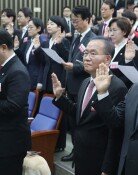Swift investigation needed for unearthing the truth
Swift investigation needed for unearthing the truth
Posted September. 28, 2021 07:19,
Updated September. 28, 2021 07:19
It has been revealed that the business risk for the development of the controversial Daejang-dong district was evaluated to be low by Korea Housing Finance Corporation (HF). According to the HF’s documents from 2018, the supply of apartments in the district would be sold out within three months with ease. This assessment served as the grounds for the HF to stand surety for Hwacheon Daeyu, an asset-management firm involved in the scandal, to borrow funds from banks. The circumstances are a far cry from Gyeonggi Gov. Lee Jae-myung’s claim that the massive profits enjoyed by Hwacheon Daeyu was a high risk and a high return.
According to the HF analysis, the Daejang-dong district project was designed to enjoy profits even when 20% of the supplies are left unsold. This means almost a zero risk for the project. Such judgments had consistently been proposed from the early phrase of the Daejang-dong project. In a feasibility study conducted by Seongnam Development Corporation (SDC) back in 2015, the Daejang-dong project was considered to excel at both sales and business prospects. In the trial on Gov. Lee’s alleged exaggeration over the success of Daejang-dong project, an SDC employee gave a testimony that “In March, 2017, the Daejang-dong development project was a safe bet without any risk factors.”
The reason why they underestimated the risk was because they used the format for a public project. As far as housing development projects go, securing land is the hardest part. For the Daejang-dong project, private land was subjected to expropriation by public sway. Some of those who conceded their land are still complaining that the compensation they received was only around half the market prices. This gives a reason to believe that private procurement of land would have triggered conflicts with the residents, ultimately leading to the prolongation or suspension of the project.
The role of licensing also went to the SDC, which was practically running the project. Thanks to the benefit of its location, which earned it the nickname of “South Pangyo,” it was easy to predict an easy sell. In fact, the Daejang-dong project was immune to the three major risks of land, licensing, and sales by design. According to an account of the SDC establishment opinion secured by Rep. Kwon Eun-hee of the People Power Party, Gov. Lee expected the Daejang-dong project to yield more than 300 billion won in profits in his 2012 city council report. It can be derived that his argument for the establishment of SDC was based on the high profitability of public projects.
At the heart of the latest controversy is the fact that civilians have enjoyed massive profits from public projects without taking any risk. Gov. Lee’s camp claims that the risk was high, but the evidence found so far point to the exact opposite. The reason the residents of Daejang-dong accepted the expropriation was because they believed it was a “public” project. They sacrificed their rights of ownership for the sake of public good. But in the end, the public bore the brunt of risks, and some individuals reaped the fruits. From the project accountment to sale of apartments, every facet of this scandal under the disguise of public works must be laid bare for justice.







